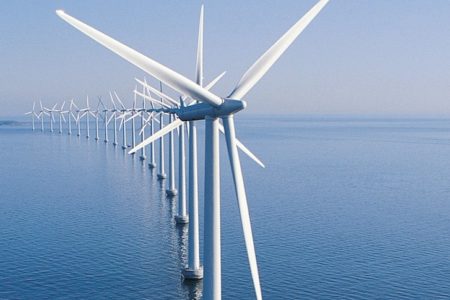November 27, 2019 – Siemens, the German manufacturer of a wide range of technologies, has just revealed a way to channel offshore wind farm airflows to optimize energy production.
Called Wake Adapt, this is technology mimicking nature. The prime example of wake adaptation can be found in the V formations used by geese and other bird species. As the birds flap their wings a rotating vortex of air flows from each wingtip. The air immediately behind the lead bird in the V is pushed downward while the air to the side of each wing gets pushed upward. A bird flying immediately behind would be negatively impacted, but a bird flying just to the side would gain the benefit of the free uplift and use less energy in flight.
Wind farms on the water are also in formation, not necessarily Vs but often in parallel like the image seen below. Wake Adapt software, like the birds in V formations, produces wake-steering to ensure a more powerful flow of air follows the “lead” turbine. The software adjusts the yaw of individual wind turbines trailing the lead to maximize the energy yield from increased airflow over the vanes.
How much of an increase? Siemens states that a wind park’s performance in terms of energy production can increase by 1% through the application of the software, and reduces the negative wake effect by as much as 10% across the entire wind farm.
How does that translate into electrical power for heating, lighting, and cooling? Using statistics from 2017 when wind power capacity reached 18.8 Gigawatts, a 1% increase equalled 188,000 kilowatt/hours which was sufficient to power 6,000 more U.S. homes annually than without the software.
Siemens is currently installing the software on Direct Drive and Geared G4 series wind turbines and can retrofit all existing inventory of deployed offshore windfarms to use it. The patent is held by The Netherlands Organization for Applied Scientific Research, who partnered with Siemens in Wake Adapt’s development.
States Morten Pilgaard Rasmussen, Head of Offshore Technology at Siemens Gamesa, “The Wake Adapt feature is about proactive problem-solving. Instead of letting the wind and wake fully dictate how much energy we can capture, we safely direct the wake, and its unfavorable effects, away from our machines across the entire power plant. Through digitalization, we can produce more energy from the same turbines, benefiting our customers, ratepayers, and society overall.”
Wake Adapt is customizable to individual offshore wind turbine installations, is remotely activated and automatically adjusts the headings of individual turbines to produce more powerful and undisrupted winds for trailing turbines. Capturing more of the latent energy from the wind means turbine efficiency improvements at the individual unit level as well as for the entire wind farm installation.
As the largest offshore wind turbine producer in the world, Siemens recognizes the industry potential for growth in the face of creating low-carbon energy alternatives to coal, other fossil-fuel, and nuclear power. The annualized industry growth rate is expected to be 13% and to continue at that pace through 2025.









